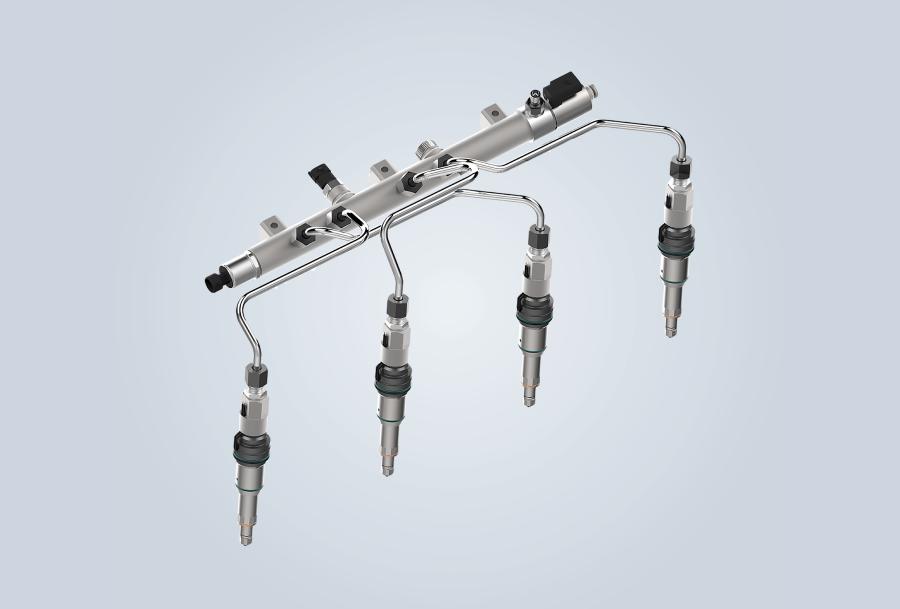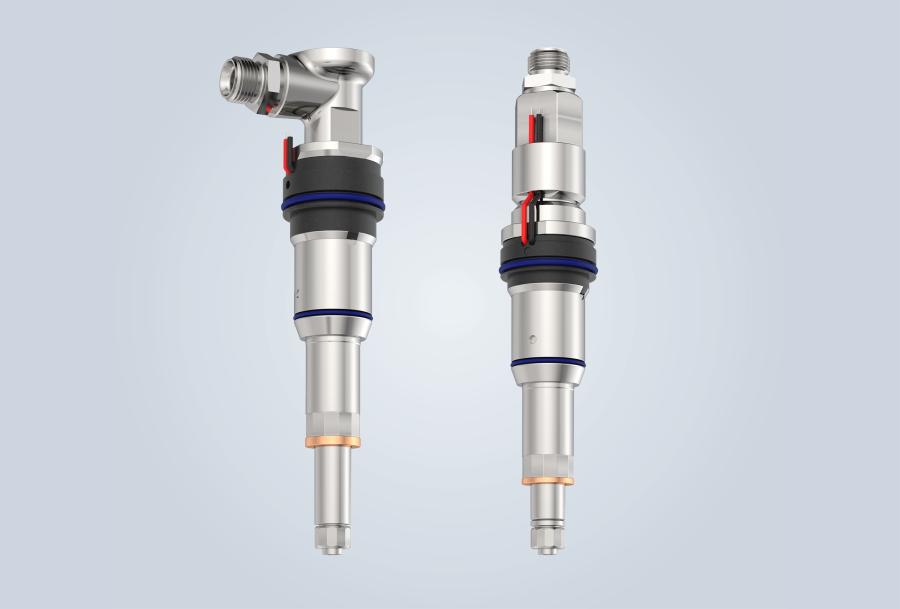Flexibility for customer interfaces is offered by the H2 injector through axial or radial inputs.
At ConExpo 2023, Liebherr presented a hydrogen direct injection solution for heavy-duty combustion engines. With this technology, the company aims to achieve maximum power density equal to the one of a conventional combustion engine.
Hydrogen-based powertrains are an important part of Liebherr's technology-open approach to alternative powertrain concepts.
Hydrogen Direct Injection: What's Behind It?
The aim of matching the performance of an H2-DI engine to that of a diesel engine requires the system to be capable of ensuring high flow rates. Due to the low density of hydrogen gas, the injector needs to be a high flow design.
To enable precise control of even the smallest quantities, the system pressure must be regulated with pinpoint accuracy. In Liebherr's H2 injection system, this is achieved by means of a gas volume control valve. Additionally, it is important to ensure that the injector has zero leakage and is gas-tight.
"To achieve the same drivability with an H2 system as with a diesel, the hydrogen injection system must be optimally aligned with the engine's torque and power," said Richard Pirkl, managing director of technology and development at Liebherr-Components Deggendorf GmbH.
"This means that during the transition from idle to full load, the necessary amount of fuel and the corresponding system pressure must be made available as quickly as possible."

Liebherr's H2-DI solution comprises a fully comprehensive injection system including pressure control.
System Design Low Pressure Direct Injection (LPDI)
Liebherr's H2 injection system is designed to provide extremely fast and accurate pressure control, regardless of fuel tank position, machine size, layout or engine installation. This design provides a two-stage pressure control.
While the first stage initially stabilizes the variable pressure from the fuel tank, the second stage fine-tunes said pressure. The injection pressure is controlled by activating the gas-metering valve via the electronic control unit (ECU).
The ECU controls the gas-metering valve by a closed-loop feed-forward controller. Custom-developed hydrogen-specific software modules can be integrated into third-party application software and/ or control units.
"The H2-DI system is designed to operate without an electronic pressure release valve. The idea behind it is to keep the system as simple as possible, whilst avoiding the release of any hydrogen gas into the atmosphere during operation," Pirkl said.
The Injector: A Key Component
"The injector is the most sophisticated and, at the same time, performance-determining component of the hydrogen fuel system," said Pirkl.
The overall dimensions of Liebherr's H2 LPDI injector are similar to those of diesel injectors for heavy-duty commercial vehicle engines. In particular, the critical maximum outer diameter is within the same range as for diesel injectors.
In the current sample stage, the injector can be equipped with various hydrogen connections by means of a screw-in insert. Two basic variants of the injector head (radial and axial H2 inlet) allow for different installation situations. To ensure the correct spray pattern and jet direction, the injector nozzle is equipped with a diffuser cap.
"It is interchangeable in the sample stage and allows cost-effective testing of different variations to define the best configuration. Using a screw-on solution, the diffuser cap can be easily replaced," said Pirkl.
The injector is opened and closed via a needle that is directly activated by an energized coil. To meet the target housing dimensions, the coil has been enlarged. The challenges thereby were to achieve sufficient electro-magnetic force for direct activation, while matching the critical external dimensions in the coil area to the engine manufacturer's requirements. Multiple simulations of different coil concepts, materials and installation situations were tested throughout the process.
The electromagnetic force was tuned to ensure that the proper opening of the injector is possible, while minimizing the closing delay.
"An additional key development goal was to control the hydrogen injector with the existing engine control units, as well as the current standard profiles already known from these applications," Pirkl said.

The asymmetrical geometry of the diffuser caps allows a wide variety of injection angles.
Test Results at a Glance
As previously mentioned, the tightness of the hydrogen injector against hydrogen is one of the biggest challenges in the development of H2 components. Tests on a vacuum leakage test rig show very good results for Liebherr's current injector design.
"Measured injection rates of the current sample already show extremely stable progressions. Overall, the injector displays a good opening and closing behavior," said Pirkl.
"On the functional test bench, we have been able to show good control of the injection rate at different pressure levels. The required minimum injection rates of approximately 0.0005 oz. per stroke are achieved at 145 psi rail pressure".
Liebherr has carried out all the tests with a completely dry-running injector without any additional lubricating oil. Since the injector was developed exclusively for hydrogen and, thus, no concepts and parts of a natural gas or gasoline injector platform were used, the focus was on the dry-running capability of the moving components. The Liebherr team in Deggendorf is currently performing endurance testing.
Hydrogen Direct Injection: Current Development, Outlook
Hydrogen direct injection is particularly well suited for applications with high demands on dynamics and power density within a limited installation space and is a feasible concept, which Liebherr in Deggendorf is further developing.
"Product validation will be one of the most important tasks in the development of hydrogen fuel systems in the future," said Pirkl. "The next steps are to optimize the low-pressure DI system in terms of injection stability and dynamic performance. Based on the low-pressure DI system for heavy-duty engines, we are also developing and testing a system with higher flow rates for larger engines."
In parallel, Liebherr is working on H2 PFI injectors. The system approaches for port fuel injection and direct injection use a common, scalable injector platform as the basis. With this extensive product portfolio, Liebherr meets a wide range of engine requirements and enables a broad spectrum of applications for medium and heavy-duty engines, as well as large engines.
For more information, visit www.liebherr.com.
Today's top stories
















